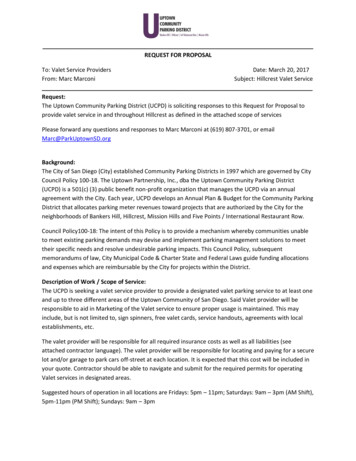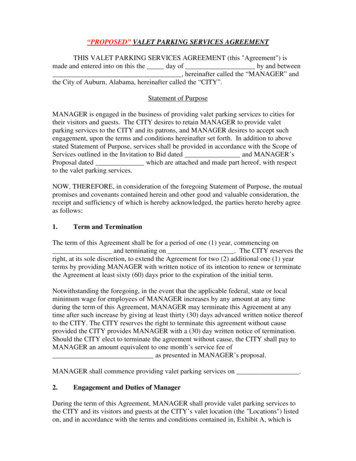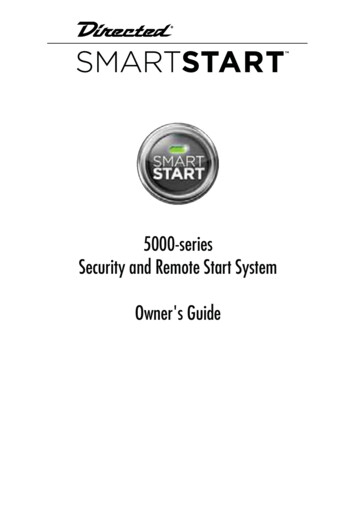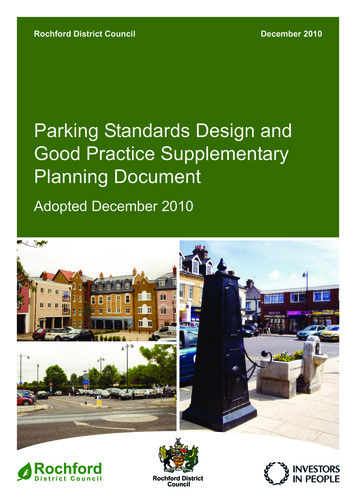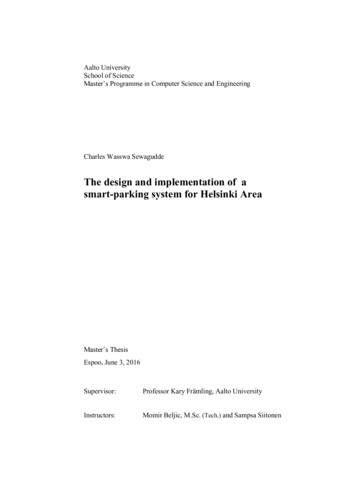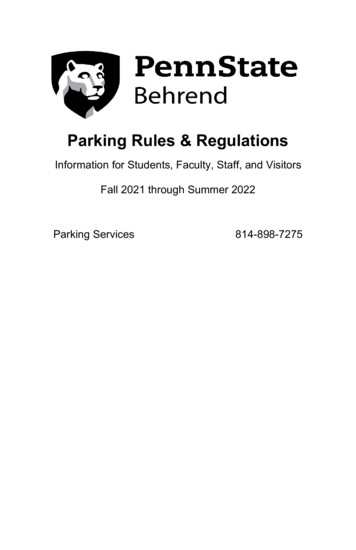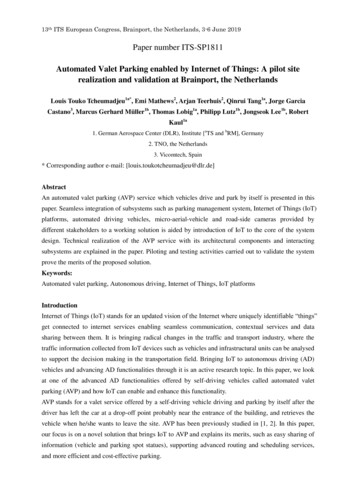
Transcription
13th ITS European Congress, Brainport, the Netherlands, 3-6 June 2019Paper number ITS-SP1811Automated Valet Parking enabled by Internet of Things: A pilot siterealization and validation at Brainport, the NetherlandsLouis Touko Tcheumadjeu1a*, Emi Mathews2, Arjan Teerhuis2, Qinrui Tang1a, Jorge GarciaCastano3, Marcus Gerhard Müller1b, Thomas Lobig1a, Philipp Lutz1b, Jongseok Lee1b, RobertKaul1a1. German Aerospace Center (DLR), Institute [aTS and bRM], Germany2. TNO, the Netherlands3. Vicomtech, Spain* Corresponding author e-mail: [louis.toukotcheumadjeu@dlr.de]AbstractAn automated valet parking (AVP) service which vehicles drive and park by itself is presented in thispaper. Seamless integration of subsystems such as parking management system, Internet of Things (IoT)platforms, automated driving vehicles, micro-aerial-vehicle and road-side cameras provided bydifferent stakeholders to a working solution is aided by introduction of IoT to the core of the systemdesign. Technical realization of the AVP service with its architectural components and interactingsubsystems are explained in the paper. Piloting and testing activities carried out to validate the systemprove the merits of the proposed solution.Keywords:Automated valet parking, Autonomous driving, Internet of Things, IoT platformsIntroductionInternet of Things (IoT) stands for an updated vision of the Internet where uniquely identifiable “things”get connected to internet services enabling seamless communication, contextual services and datasharing between them. It is bringing radical changes in the traffic and transport industry, where thetraffic information collected from IoT devices such as vehicles and infrastructural units can be analysedto support the decision making in the transportation field. Bringing IoT to autonomous driving (AD)vehicles and advancing AD functionalities through it is an active research topic. In this paper, we lookat one of the advanced AD functionalities offered by self-driving vehicles called automated valetparking (AVP) and how IoT can enable and enhance this functionality.AVP stands for a valet service offered by a self-driving vehicle driving and parking by itself after thedriver has left the car at a drop-off point probably near the entrance of the building, and retrieves thevehicle when he/she wants to leave the site. AVP has been previously studied in [1, 2]. In this paper,our focus is on a novel solution that brings IoT to AVP and explains its merits, such as easy sharing ofinformation (vehicle and parking spot statues), supporting advanced routing and scheduling services,and more efficient and cost-effective parking.
Automated Valet Parking enabled by Internet of Things: A pilot site realization and validation atBrainport, the NetherlandsAVP has been developed as part of the European Union project AUTOPILOT [3] (AUTOmated drivingProgressed by Internet Of Things) with the objective to bring together knowledge and technology fromautomotive and IoT value chains to develop IoT-architectures and platforms which bring AD towards anew dimension. AUTOPILOT IoT enabled AD cars are tested at six large-scale pilot sites in Finland,France, Italy, the Netherlands, South Korea and Spain. The AVP solution presented in this paper is theone developed and tested at the Brainport site in the Netherlands.AVP storyboardA new AVP service has been introduced where users can leave/retrieve their car at the doorsteps of thebuilding where they plan to visit and let the car drive and park automatically at a nearby parking lot.Figure 1 explains a typical use of this service. Bob, a user of the AVP service arrives at the drop-offstation and uses the app in his smartphone to use the service. On entering the credentials the appconnects to the parking manager to check for a free parking spot in the nearby parking lot. The fixedcameras at the parking lot notify the parking manager on the occupancy status of the parking lot.Unfortunately, on this very busy day all parking spots monitored by the fixed cameras are reported asoccupied. Hence, the parking manager seeks the assistance of drones that are employed to support AVP.Drones can check the status of the parking spots not observable by the fixed cameras or provide anaccurate status of the parking spots in case of conflict resolutions. The drone sets off its flight and findsa free parking spot. The parking manager assigns it to Bob’s car and the routing service provides theroute information. Bob accepts the suggested parking spot and sends his car to park using the App. Cardrives automatically to the dedicated parking spot and parks. Bob goes to his appointment and gets theconfirmation once the car has been parked. After the meeting, Bob retrieves his car using the App.Step 1: Arriving at the drop-offStep 2: AUTOPILOT-AVP AppStep 3: Fixed cameras updatingpositionrequesting a parking spotparking spot occupancy statusStep 4: Drone searches andStep 5: App displays the route toStep 6: Automated parking at theconfirms a free parking spotthe parking lotparking spotFigure 1: Typical use of AVP service2
Automated Valet Parking enabled by Internet of Things: A pilot site realization and validation atBrainport, the NetherlandsAVP IoT architectureThe AVP IoT architecture developed for the Brainport pilot site is depicted in Figure 2. It is built onstandard IoT architectures with key features such as openness, flexibility, interoperability between IoTplatforms. It consists of three main parts: 1) the AVP applications, which contains services to the ADvehicles and users such as parking management, user management and routing services, 2) IoTplatforms, which enables the IoT functionalities such as device management, context management,process and service management, semantics, analytics and security, and 3) things, which includes IoTdevices such as AD vehicles, Roadside Unit (RSU) cameras, and MAVs and AVP smartphone App.Figure 2: IoT system architecture of the automated valet parking use case in BrainportAVP applications: Parking Management Service (PMS) manages one or more parking sites, keeps anup-to-date status of parking lots and makes their reservation. It interfaces with the IoT AVP Application thatmakes the external communication with IoT platforms over MQTT or RESTful interface [4].IoT platforms: AUTOPILOT project supports a federated IoT platform architecture, which means thatseveral layers of IoT platforms are supported and they can be deployed on a variety of physicalinfrastructures. Two cloud-based IoT platforms are employed in the Brainport AVP pilot realization,namely Watson IoT Platform from IBM [5] and oneM2M platform from SENSINOV [6].IoT devices: AD vehicles considered in the AVP includes two pilot vehicles provided by the GermanAerospace Center (DLR) and Netherlands Organisation for applied scientific research (TNO),respectively. The AD vehicles publish event messages and receive command messages to/from the IoTplatform during the parking and collection processes.IoT platforms’ interworking gatewayTwo cloud-based IoT platforms, Watson IoT and oneM2M work seamlessly in the AVP pilot site,compared to the contribution described in [2]. A bidirectional interworking gateway connector allowsthe interoperability between the two platforms. This is achieved by setting oneM2M as an3
Automated Valet Parking enabled by Internet of Things: A pilot site realization and validation atBrainport, the Netherlandsinteroperability platform and using oneM2M interworking gateway for connecting other platforms (i.e.Watson IoT) to it. The interworking gateway is configured to share selected data types of otherplatforms with the interoperability platform. Such data will then become accessible to all the connectedIoT platforms through the interoperability platform.AVP IoT information flowA schematic view of the AVP IoT information flow implemented in the Brainport pilot site is shown inFigure 3. Data is exchanged using AVP data model developed based on the SENSORIS [7] and DATEXII [8] standards. D1: Camera AVP Event Data, namely parking spot occupancy and obstacle data are published tooneM2M platform. The PMS subscribed to this information gets it from the Watson IoT platformthrough the interworking gateway. D2: Vehicle AVP Command Data, namely park or collect the AD vehicle, initiated from the usersApps goes to PMS which publishes it to the Watson platform. DLR vehicle directly subscribed to itreceives it from the Watson platform whereas TNO vehicle gets it from the oneM2M platform. D3: Vehicle AVP Event Data, namely vehicle status and position estimates, being published to theWatson and oneM2M platforms by the DLR and TNO vehicles, respectively is received by PMS bysubscribing to it from the Watson platform. It is then processed and published to the Watson platformFigure 3: AVP IoT information flowwhich is subscribed by the app and show live updates of vehicle status to the users. D4 and D7: Parking Spot Occupancy and Obstacle Data received by the PMS from the RSU camerasare processed and published to Watson and oneM2M IoT platforms for external applications to use. D5: MAV AVP Event Data are published to the Watson IoT platform and PMS which subscribes tothem, processes and publishes as in D4 and D7. D6: MAV AVP Command Data: AVP Monitoring unit initiates the command to fly MAVs. PMSreceives this and publishes the command data to the Watson IoT platform. MAV subscribed to this4
Automated Valet Parking enabled by Internet of Things: A pilot site realization and validation atBrainport, the Netherlandscommand receives it and acts accordingly.Vehicle PlatformsTwo connected and automated vehicle prototypes from DLR and TNO have been used in the Brainportpilot site for AVP (see Figure 4). In this section the integration of IoT technology in vehicle and theadaptation of autonomous function to enable the IoT based autonomous driving are described.TNO / TASS TUe ToyotaDLR‘s prototype Volkswagen e-GolfFigure 4: Connected and automated vehicle prototypes in Brainport pilot siteAutomation functions adaptation in vehicle to enable IoT autonomous drivingThe DLR prototype FASCarE is a fully electric Volkswagen e-Golf. The vehicle was modified to allowaccess to OEM sensors and actuators for longitudinal and lateral control and equipped with additionalhardware. This includes radar and laser sensors, a differential GPS system, several industrial PCs forrunning the AD functionality, a 4G communication unit and a custom dashboard display.The software was only slightly adapted, e.g. an IoT gateway module was added. The main humanmachine interface (HMI) for the user is the Valet Parking App, the in-vehicle HMI was mainly used fortesting and debugging.Figure 5: Adaptation of autonomous functions in DLR’s vehicle prototypesThe trajectory planning is based on optimal control. It respects speed limits and avoids obstacles. Anadditional trajectory planning mode for reverse parking was added for the use case.The function management module acts as a higher-level control centre for trajectory planning and otherfunction modules below, setting planning goals and switching modes of control. The functionmanagement handles communication with the IoT platform; it provides a translation of parkingcommands from the AVP Parking Management System into sequenced goals for the trajectoryplanning.5
Automated Valet Parking enabled by Internet of Things: A pilot site realization and validation atBrainport, the NetherlandsThe main contributions involves the development of HD-map functions (and related to that: thelocalization), the modification of the existing supervisory control that handles the commands to thesystem and the addition of a IoT gateway function to connect the in-vehicle AVP-application to anexternal IoT Parking Service.Integration of IoT technology in vehicleThe final DLR architecture is based on ROS and the proprietary DLR Dominion Environment IPCplatform. ROS is best suited for sensor fusion tasks and also integrates the IoT client module, whileDominion is better suited for high frequency real-time control tasks and AD planning.Figure 6: IoT software components architecture diagram of the DLR and TNO vehicles respectivelyThe in-vehicle control software for TNO vehicle is developed within the ROS-framework. All sensorsand actuators are, either directly over Ethernet or via a CAN-gateway, connected to the ROS-network.Within this network, the AVP-application is divided over several nodes, all having their specificfunctions namely localization, object tracking, path planning, path tracking controller and IoT gateway.The Micro-Aerial-Vehicle (MAV)The task of the MAV is to autonomously observe the status of particular parking spots. The use of aflying platform is especially useful in scenarios where it is difficult or inefficient to install road sidecameras. This can be in cases where the parking spot structure is built up temporarily and on roughterrain, like sometimes found on festivals. It can also be used in scenarios, where the road side camerashave failed or are uncertain about their observation due to occlusions or other difficulties.Figure 7: MAV and stereo camera setup and field of view6
Automated Valet Parking enabled by Internet of Things: A pilot site realization and validation atBrainport, the NetherlandsThe MAV used in this paper is equipped with two pairs of stereo cameras, which consists of fourwide-angle cameras. The camera setup provides an approximated 240 vertical field of view asillustrated in Figure 7. The arrangement of the cameras and the separate control of them make the systemwell suited for outdoor scenes with high dynamic range situations. For navigation the MAV is using avisual-inertial approach which is described in [9].The MAV is waiting for a command from the parking management system at its starting position on theground. Once the MAV receives the request to check the status of a particular parking spot, it flies to itand takes an image of the parking spot. The image is sent to a base station, which is running objectdetection software to determine whether the parking spot is occupied. Then the result is sent to the IBMWatson IoT platform. The Parking Management Service receives the status and MAV telemetry data overMQTT and processes this information for decision-making. After the image was processed, the MAV isflying back to its starting position.The Road Side Unit (RSU) cameraTo support AVP, panoramic and multi-sensor road side cameras are installed in the area where theautonomous vehicles are driving and parking. The cameras are located throughout the environment atdifferent positions, from the drop-off point, the lanes/access roads to the parking lot. The road sidecamera network is responsible to provide information of different video analytics, which will bepublished in the IoT. Specifically, the role is to provide the status of parking spots and detections of staticobstacles disabling any driving area. To do this, video streams are transmitted to a back-office processingserver where the video analytics are executed in multiple instances, one instance for each tuplecamera-analytic. All detected events are formatted using specific data models and, subsequently, sentover to a high-level communication entity, which then publishes the oneM2M platform.AvailableNon-AvailableFigure 8: AVP road unit camera and parking lot detection visualizationThe free parking spot detection module is composed by two different parts. Localization of parking spotsis the image region which corresponds to each parking spot. Assuming that the road side camera is static,this task has been manually performed using an image annotator application where each parking spot isdefined by 4 corners. Once all parking spots are annotated, metadata are stored in a configuration file.Then, a parking spot monitor application is in charge of the classification of parking spots to determine ifthey are occupied or available using a convolutional neural network (CNN). Figure 8 shows a snapshotof the parking spot monitor application where the status information can be differentiated by means ofthree colours: green means the parking spot available, red means occupied and blue means unable to be7
Automated Valet Parking enabled by Internet of Things: A pilot site realization and validation atBrainport, the Netherlandsclassified since the accuracy of the parking spot is too low.The static obstacle detection module combines short-term and long-term background models to extractstatic foreground objects. Once the static obstacle monitoring starts, information including its GPSlocation is periodically transmitted to the IoT by using specific data models. Similarly, when the staticobstacle is removed from the environment a last message is sent to notify that the driving area is againavailable.AVP piloting and technical evaluation in BrainportAVP pilot siteAVP pilot site in Brainport located at the Automotive Campus, Helmond is shown in Figure 9. Visitorsto the campus can leave the car at the drop-off point in front of the campus and the car will drive to theparking lot at the back of the campus and park there. Vehicle can use two routes highlighted in bluecolour and the access roads to the parking lot are monitored by five cameras as shown in Figure 9.Additionally, two cameras are installed in the parking lot to cover that area.Figure 9: AVP test site and equipment in the pilot site BrainportAVP piloting activity and resultsThe piloting activity has started in September 2018 and will be continued until June 2019 in dedicatedpiloting weeks in every quarter of the year. The first piloting week in September 2018 verified thatcomponents and interfaces work according to specification and validated that the integrated system issuited for piloting. At the second piloting week in December 2018, user acceptance test was carried outwith several nontechnical end users from the Automotive Campus tested AVP service. Users sit insidethe car to experience the autonomous driving and parking while a safety driver explains the onscreenvisualizations to them. In the next round, they move to the demo booth to see the working of thesystem from the backend visualizations. The pilot runs were completed successfully and based on thefeedback received from these users further improvement of the system is carried out.8
Automated Valet Parking enabled by Internet of Things: A pilot site realization and validation atBrainport, the NetherlandsFigure 10: MAV parking spot occupancy detection, left: occupied, right: freeDuring four piloting rounds, the MAV received commands to check the occupancy status of twodifferent parking spots which were once occupied and three times unoccupied. In all these runs, theMAV detected the occupancy status of the parking spot correctly. Figure 10 shows a visualization of theobject detection by the MAV; the dot shows where in the image the occupancy status is evaluated on.AVP validation experimentsIn addition to piloting activities, for technical evaluation of the system we have defined following testscenarios, which will be executed in several rounds (at least 20 rounds) during the test week of June2019.1. Autonomous drop-off (DO) / pickup (PU) with TNO and DLR vehicles without or with obstacle Without obstacles: vehicle takes the shorter route from/to drop-off / pick-up zones With obstacles: obstacle is present before the driving and vehicle takes the longer route2. Parking spot (PS) occupancy and obstacle detection in different traffic and weather conditions withRSU camera or the MAV3. Routing service: calculation of optimal route a) without obstacle (see Figure 12), b) with obstaclewhen RSU camera or vehicle detects obstacle prior to navigation (see Figure 13), and c) withobstacle but detection after setting off.Figure 11: Road networkFigure 12: Route A - shorterFigure 13: Route B - longer routeand parking spots (PS)route from the DO to PSfrom the DO to PS with obstacle onwithout obstaclethe shorter routeThe key performance indicators (KPI) that will be measured during the subsystem tests are accuracy,reliability, and robustness, whereas the KPIs measured during the integrated tests will be parkingduration, percentage of successful autonomous driving, and percentage of successful autonomousparking.Conclusion and outlookThe technical solution of the AVP enabled by IoT is presented in this paper. The seamless integration ofmultiple (IBM Watson and oneM2M) IoT platforms, multiple (DLR and TNO) AD vehicles,smartphone Apps, MAV and RSU cameras into a valet parking service is enabled by IoT. Piloting9
Automated Valet Parking enabled by Internet of Things: A pilot site realization and validation atBrainport, the Netherlandsactivities and technical tests confirmed the success of our solution. The ongoing work is to improve theuser experience based on the feedback received and apply the solution in more challenging scenarios.AcknowledgmentThis work has been supported by the European Commission within the European Union’s Horizon2020 research and innovation programme funding, Project AUTOPILOT [3] under Grant AgreementNo. 731993. Special thanks to D.A. de Klein from the City of Helmond for facilitating the pilotingactivities at Automotive Campus, Helmond, the Netherlands.References1. Löper, Christian; et.al. (2013): Automated Valet Parking as Part of an Integrated Travel Assistance.In: IEEE (Hg.): Proceedings of the IEEE ITSC 2013. IEEE Intelligent Transportation SystemConference. The Hague, The Netherlands. IEEE, S. 2341–2348.2. Touko Tcheumadjeu, Louis Calvin; et.al. (2018) Integration of an Automated Valet ParkingService into an Internet of Things Platform. In: Procedings of the 21st IEEE InternationalConference on Intelligent Transportation Systems. IEEE ITSC 2018, 04.-07.Nov.2018, Hawaii,USA.3. AUTOPILOT project web page: http://autopilot-project.eu. Accessed on 11 January 20194. MQTT official website, http://mqtt.org. Accessed on 11 January 2019.5. Watson IoT for Automotive: Q4V/iot-automotive/overview/overview.html. Accessed on 11 January 2019.6. oneM2M - Standards for M2M and the Internet of Things: http://onem2m.org/. Accessed on 11January 2019.7. SENSORIS web page: https://sensor-is.org. Accessed on 11 January 2019.8. DATEX II User Guide, Q4V/iot-automotive/overview/overview.html. Accessed on 11 January 2019.9.Müller, Marcus Gerhard et al. (2018): Robust Visual-Inertial State Estimation with MultipleOdometries and Efficient Mapping on an MAV with Ultra-Wide FOV Stereo Vision. In: IEEEInternational Conference on Intelligent Robots and Systems. IROS 2018, 01-05 Oct 2018, Madrid,Spain10
devices such as AD vehicles, Roadside Unit (RSU) cameras, and MAVs and AVP smartphone App. Figure 2: IoT system architecture of the automated valet parking use case in Brainport AVP applications: Parking Management Service (PMS) manages one or more parking sites, keeps an up-to-date status of parking lots and makes their reservation.
